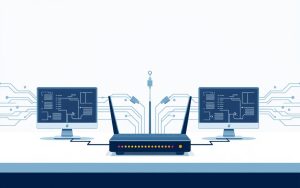Computer networks transform digital communication. They enable seamless data sharing across devices and locations. These networks go beyond simple connectivity, changing how we exchange information.
ARPANET emerged in the late 1960s, sparking network evolution. Today, networks connect billions of devices worldwide. They support critical communication for businesses, schools, and personal use.
Modern networks serve three main purposes. These are resource sharing, communication optimization, and secure data transmission. Over 80% of organizations use networks to cut costs and improve information exchange.
Networks come in different forms. Local Area Networks (LANs) operate in offices. Wide Area Networks (WANs) span continents. These frameworks boost collaboration and information access.
About 95% of businesses rely on networks for essential tools. These include email and video conferencing. As technology advances, networks remain crucial to global digital infrastructure.
Computer networks drive innovation across sectors. They connect people and businesses around the world. Their importance in our digital world continues to grow.
Understanding Computer Networks: Basic Concepts and Architecture
Computer networks are complex systems that connect devices for digital communication. They allow organizations and individuals to share information and work together. These networks have changed how we exchange data and collaborate.
Network components form the backbone of digital infrastructure. They use advanced technologies to enable smooth communication. Let’s explore the key elements that make computer networks work effectively.
Network Components and Infrastructure
Network infrastructure includes important hardware and software elements. These parts work together to transmit data. Key components include:
- Routers that direct network traffic
- Switches for connecting multiple devices
- Network interface cards (NICs)
- Servers and client machines
- Transmission media like cables and wireless signals
Types of Network Connections
Different network connections meet specific communication needs:
| Network Type | Coverage | Typical Use |
|---|---|---|
| LAN | Single building | Office/home networks |
| WAN | Global/continental | Interconnecting distant locations |
| MAN | City-wide | Metropolitan communication |
Network Protocols and Communication Standards
Communication protocols are vital for standardizing data transmission. The TCP/IP model provides a framework for network communication. It defines how data packets are exchanged between devices.
Protocols like HTTP, FTP, and SMTP ensure reliable and secure data transfer. They enable efficient communication across various network architectures. These protocols allow different systems and devices to interact smoothly.
What Is the Primary Function of a Computer Network
Computer networks are the backbone of modern digital communication. They enable seamless data transmission across various devices and systems. These networks create a robust infrastructure that supports complex information exchange.
The network purpose covers several key aspects of digital interaction. These include fast communication, resource sharing, and centralized data management. Networks also support collaborative work environments.
- Facilitating rapid and efficient communication
- Sharing resources across multiple devices
- Centralizing data storage and management
- Supporting collaborative work environments
Different network types offer unique capabilities for organizations and individuals. Local Area Networks (LANs) connect devices within a limited space. Wide Area Networks (WANs) enable communication across vast geographical regions.
| Network Type | Communication Range | Primary Use |
|---|---|---|
| LAN | Single building | Internal organizational communication |
| WAN | Global | Inter-organizational data transmission |
| Personal Area Network | Individual device ecosystem | Personal device connectivity |
Computer networks originated with ARPANET in the late 1960s. This early network laid the groundwork for modern internet infrastructure. Today, networks drive digital innovation in business and personal communication.
Network Topologies and Structures
Network topology is key for designing efficient, secure computer networks. Network configuration determines how devices communicate and share resources.

Common Network Configurations
Network topologies offer unique benefits for different computing environments. Here are the most common network setups:
- Star Topology: Connects multiple client devices to a central server, enhancing performance and reliability
- Mesh Topology: Ensures maximum redundancy by connecting every node to every other node
- Bus Topology: Connects nodes in a linear sequence, allowing unidirectional data transmission
- Ring Topology: Links nodes in a circular pattern, enabling bi-directional data flow
Physical vs. Logical Network Design
Network topology goes beyond physical connections. Software-defined networks allow centralized traffic routing through digital interfaces. This enables dynamic adaptation to changing network conditions.
Network Security Architecture
Network security is crucial in modern network design. Advanced strategies use multiple security layers for protection.
- Encryption methods
- Access control mechanisms
- Endpoint device compliance checks
Robust network security architecture protects sensitive data and prevents unauthorized access. It also maintains optimal network performance for organizations.
Essential Benefits of Computer Networking
Computer networks have changed how we communicate and share resources. They go beyond simple connectivity, reshaping our work, learning, and interactions. These networks are crucial in our digital world.
Key network advantages include:
- Enhanced collaborative computing capabilities
- Centralized data storage and management
- Efficient resource sharing
- Improved communication infrastructure
Networks boost productivity in organizations. They allow many users to access important data at once. This cuts down on duplicate work and improves efficiency.
| Network Benefit | Impact |
|---|---|
| Resource Sharing | Reduces hardware costs by 40% |
| Collaborative Computing | Increases team productivity by 35% |
| Data Accessibility | Enables real-time information exchange |
Networks power vital digital services like email and cloud apps. These tools enable global communication, breaking down distance barriers. They support smooth teamwork across different places and time zones.
Modern networks use strong security measures to combat cyber threats. About 60% of small businesses face cyber attacks within six months. This shows why secure network systems are so important.
Conclusion
Computer networks have evolved tremendously since the 1960s ARPANET. They now connect billions of devices globally. This network growth has driven innovation and changed how organizations communicate and operate.
By 2025, global data traffic may reach 175 zettabytes. This highlights the increasing need for strong network technologies. The future of networking depends on tech improvements in performance, security, and connectivity.
Organizations benefit greatly from these advancements. Cloud services can cut IT costs by 40%. Improved collaboration can boost productivity by 20%. Networks are vital for supporting flexible digital workspaces as remote work grows.
Security is a top priority, with 90% of organizations focusing on network protection. VPNs can reduce unauthorized access by 80%. Good network management can improve service availability by 30%.
Computer networks show ongoing innovation in connecting people and businesses. These systems will keep driving progress and enabling new digital interactions. From local networks to global internet, they’ll shape our connected world.







